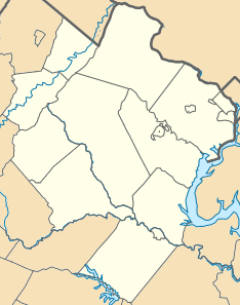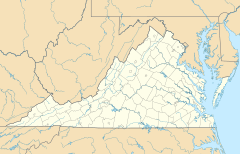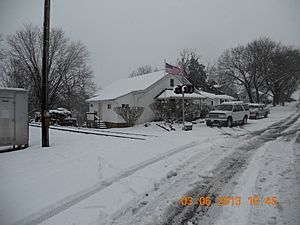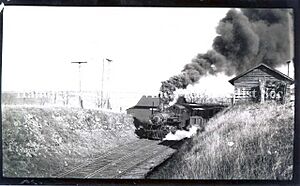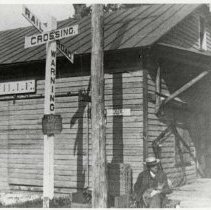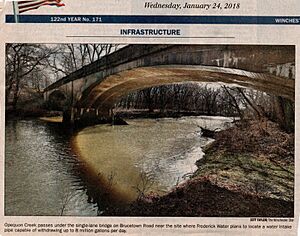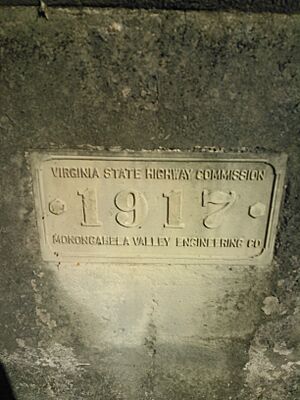Wadesville, Virginia facts for kids
Quick facts for kids
Wadesville, Virginia
|
|
|---|---|
| Country | |
| State | |
| County | |
| Time zone | UTC−5 (Eastern (EST)) |
| • Summer (DST) | UTC−4 (EDT) |
Wadesville is a small community in Clarke County, Virginia. It's not a city or town with its own government. You can find Wadesville right next to Opequon Creek, near a spot called Locke's Ford.
Contents
Wadesville's Early History
Wadesville began when the Winchester and Potomac Railroad was built. By November 1834, much of the railway was ready. The train line officially opened on March 13, 1836. Wadesville Station was an important stop, about 22 miles from Harpers Ferry. Wadesville and nearby Swimley Station were busy places, as they were the only train stops in the county for a while.
Wadesville During the Civil War
Locke's Ford was a key location during the American Civil War. Many small battles, called skirmishes, happened here. Two of the biggest fights took place just before the Second and Third Battles of Winchester.
Second Battle of Winchester Skirmish
In June 1863, Confederate General Robert E. Lee's army was moving north. General Richard S. Ewell's troops were sent to clear out Union soldiers from the Shenandoah Valley.
On the morning of June 13, 1863, General Ewell sent two divisions to attack Union troops in Winchester. His third division, led by General Robert E. Rodes, headed towards Berryville. Berryville was held by Union Colonel Andrew T. McReynolds' soldiers.
When Rode's division approached, Colonel McReynolds decided to leave Berryville. He led his troops north on Charles Town Road. They then turned northwest towards Summit Point, aiming to reach the Valley Pike and head south to Winchester.
This path took them through Locke's Ford. The front of McReynolds' group reached Valley Pike as his rear guard arrived at the ford. This rear guard included soldiers from the 6th Maryland Infantry and the 1st New York Cavalry.
Between 5:00 and 6:00 p.m., about 350 Confederate cavalrymen, led by Major James W. Sweeney, approached the ford. Sweeney's men went around the Union rear guard through some woods. A Union messenger spotted them and warned the 1st New York Cavalry.
The 1st New York Cavalry quickly got ready as the Confederates attacked. They fell back to the ford. As they retreated, Union Lieutenant Eugene Alexander was moving his artillery across Opequon Creek. He managed to pull one of his cannons up a steep bank. He then fired a special shot, called canister, at the Confederate horsemen. The 6th Maryland infantry also set up positions to protect the cannon.
The Confederate 36th Virginia Cavalry charged again. But they faced heavy fire from the 6th Maryland, more cannon shots, and a counter-attack from the 1st New York Cavalry. The Confederates had to pull back, with many soldiers injured, including Major Sweeney.
Lieutenant William Hall of the 1st New York Cavalry later said the fight was short but very intense. The Union side lost two killed, five wounded, and two captured. The Confederates lost four killed and several wounded. The Union soldiers held their position for about an hour. Once they were sure the Confederates were gone, they continued their retreat to Winchester.
Third Battle of Winchester Skirmish
In September 1864, Confederate General Jubal Early had about 15,514 soldiers. They were on the west side of Opequon Creek. Union General Philip Sheridan had about 41,173 soldiers. They were on the east side of the creek.
The area around Locke's Ford was very tense. Union patrols, like the 2nd Massachusetts Cavalry, often came under fire from Confederate soldiers guarding the ford. On September 13, Corporal Valorous Dearborn was shot and killed. The next day, three more Union troopers were killed.
The 22nd Virginia Cavalry and 51st Virginia Infantry defended the west bank of Locke's Ford. Early on September 19, around 2:00 a.m., Union Brigadier General George Armstrong Custer's Michigan Brigade started moving towards the ford.
They arrived on the east bank around 5:00 a.m. The 6th Michigan Cavalry dismounted and took positions on a hill overlooking the ford. The 7th Michigan Cavalry and 25th New York Cavalry charged the ford. They were covered by the 6th Michigan's repeating rifles.
The Union soldiers tried to cross the creek many times but were pushed back each time. Finally, other Union cavalry units crossed Rocky Ford, a mile south of Locke's Ford. This threatened the Confederate line from behind. The Confederate 51st Virginia Infantry and 22nd Virginia Cavalry, along with the 45th Virginia Infantry, had to retreat. The Michigan Brigade was then able to cross Opequon Creek after about two hours of fighting.
Fires at Wadesville Station
Wadesville Station experienced several fires over the years.
Fire in January 1916
On January 7, 1916, a fire completely destroyed the store, the Baltimore and Ohio Railroad station, and the post office in Wadesville. The fire started around 3:00 a.m., and no one knew how it began. Nothing was saved from the building, as the fire spread too quickly. Neighbors worked in the cold and snow to stop nearby buildings from catching fire.
Fire in December 1941
On December 30, 1941, another fire destroyed the Baltimore and Ohio passenger station, the post office, and William Eleyette's general store. Firefighters arrived quickly but were too late to save the building. They did manage to protect a stone garage nearby. People wondered if rats chewing on matches, a bad chimney, or a hot stove caused the fire. The building did not have electricity. It was noted that the Wadesville station had been operating for 50 years. This was also the third time a station in Wadesville had been destroyed by fire, though not always in the same spot.
The Bridge at Locke's Ford
In November 1915, people started talking about building a strong bridge over the Opequon Creek at Wadesville. This spot was a dangerous ford where the road from Brucetown to Wadesville crossed the creek. The plan was to build a steel bridge with concrete supports. It was estimated to cost about $4,000. Clarke and Frederick counties, the state, and private donations would share the cost.
In February 1917, the counties met and accepted bids for the bridge. The Monongahela Valley Engineering Co. of Morgantown, West Virginia, won the bid to build the concrete bridge for $8,964.07. The state of Virginia paid half the cost, and Clarke and Frederick counties each paid a quarter. The bridge was built in 1917.
Wadesville Postmasters
Here is a list of the people who served as postmasters at the Wadesville Post Office and when they started their jobs:
- John H.P. Stone - August 13, 1850
- Daniel Wade - December 18, 1858
- Samuel L. Pidgeon - June 12, 1865
- Samuel J. Swimley - January 4, 1875
- Bettie A. Wade - April 7, 1879
- Henry R. W. Kont - November 30, 1888
- Wiliam C. Alther - August 3, 1889
- Samuel L. Pidgeon - May 21, 1897
- Lewis Pidgeon - March 19, 1900
- William R. Elyett (Acting) - February 28, 1940
- Elwood R. Elyett - April 2, 1940
The Wadesville Post Office officially closed on March 31, 1954.
Images for kids


